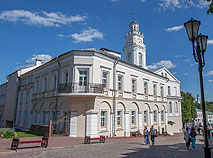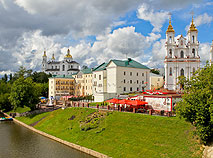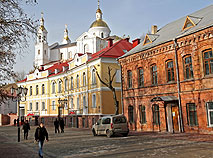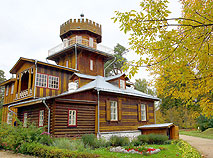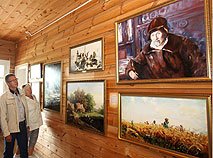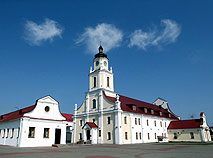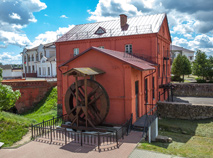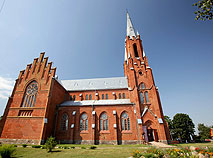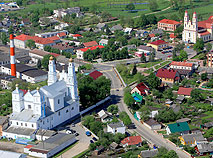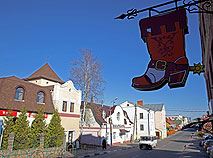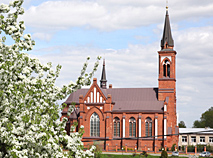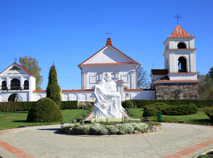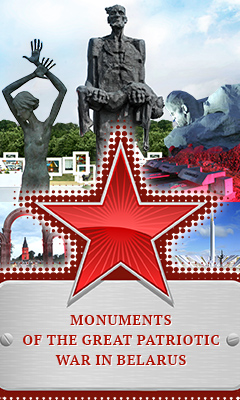Vitebsk Oblast Landmarks

The legendary land of blue lakes, ancient towns and ancient monuments where such names as Euphrosyne of Polotsk, Frantsisk Skorina, Marc Chagall, Zhores Alferov, Ivan Chersky, Lev Vygotsky came from… It was Vitebsk Oblast where the internationally recognized avant gardist Kazimir Malevich wrote his key work on suprematism, where the talented artist Ilya Repin created nearly 40 paintings and drawings. Vitebsk Oblast is home to unique natural landmarks that include Braslav Lakes National Park famous for hundreds of picturesque lakes and islands and Yelnya Landscape Reserve with some of Europe’s biggest peat bogs and glacial lakes.
Vitebsk
 A legend has it that Vitebsk was founded by Princess Olga on the banks of the Western Dvina River and the Vitba River in 947. Centuries later it was destined to become the world’s treasury of talents: Vitebsk was the birthplace of outstanding artists Marc Chagall, Kazimir Malevich, Ossip Zadkine, Ivan Puni, philosophers Nikolay Lossky and Mikhail Bakhtin… Today Vitebsk is Belarus’ biggest cultural hub that hosts the unique festival of arts Slavonic Bazaar. The city’s major landmarks include the City Hall Square, Holy Resurrection Church, Governor’s Palace, Holy Assumption Cathedral and the famous Kirov Bridge across the Western Dvina River.
A legend has it that Vitebsk was founded by Princess Olga on the banks of the Western Dvina River and the Vitba River in 947. Centuries later it was destined to become the world’s treasury of talents: Vitebsk was the birthplace of outstanding artists Marc Chagall, Kazimir Malevich, Ossip Zadkine, Ivan Puni, philosophers Nikolay Lossky and Mikhail Bakhtin… Today Vitebsk is Belarus’ biggest cultural hub that hosts the unique festival of arts Slavonic Bazaar. The city’s major landmarks include the City Hall Square, Holy Resurrection Church, Governor’s Palace, Holy Assumption Cathedral and the famous Kirov Bridge across the Western Dvina River.
![]() Vitebsk prides itself on Belarus’ biggest tram system that is over 110 years old.
Vitebsk prides itself on Belarus’ biggest tram system that is over 110 years old.
Marc Chagall Museum
 The most famous native of Vitebsk, Marc Chagall, is one of the most remarkable representatives of the global avant-garde movement of the 20th century. The famous artist created paintings and illustrations to poetry by Andre Breton, Blaise Cendrars, Guillaume Apollinaire, decorations to the Aleko ballet by Leonide Massine and the Firebird by George Balanchine, and interior of the Opera Garnier in Paris, as well as sculptures, ceramics, graphics… Being far away from Vitebsk, the painter never forgot his home town, its roofs, churches and people. By the way, people are depicted in every single painting by Marc Chagall. The Marc Chagall Museum in Vitebsk boasts one of the world’s biggest collections of the artist – over 300 original graphic works and reproductions of his most famous paintings.
The most famous native of Vitebsk, Marc Chagall, is one of the most remarkable representatives of the global avant-garde movement of the 20th century. The famous artist created paintings and illustrations to poetry by Andre Breton, Blaise Cendrars, Guillaume Apollinaire, decorations to the Aleko ballet by Leonide Massine and the Firebird by George Balanchine, and interior of the Opera Garnier in Paris, as well as sculptures, ceramics, graphics… Being far away from Vitebsk, the painter never forgot his home town, its roofs, churches and people. By the way, people are depicted in every single painting by Marc Chagall. The Marc Chagall Museum in Vitebsk boasts one of the world’s biggest collections of the artist – over 300 original graphic works and reproductions of his most famous paintings.
![]() 11 Pokrovskaya Street, Vitebsk
11 Pokrovskaya Street, Vitebsk ![]() 11.00-18.30.
11.00-18.30.
Closed on Monday, Tuesday from 1 October till 1 March; Closed on Monday from 1 March to 1 October
![]() Besides the museum, Vitebsk has the Marc Chagall Art Center (2 Putna Street) that hosts exhibitions of the artist’s graphic works and traditional Chagall Readings bringing together researchers studying the life and works of the Belarusian genius.
Besides the museum, Vitebsk has the Marc Chagall Art Center (2 Putna Street) that hosts exhibitions of the artist’s graphic works and traditional Chagall Readings bringing together researchers studying the life and works of the Belarusian genius.
Ilya Repin Museum in Zdravnevo
 The museum of the great Itinerary artist Ilya Repin is located in the suburbs of Vitebsk. In 1892 he sold one of his most famous paintings - Cossacks of Saporog Are Drafting a Manifesto - to Alexander III and bought the Sofiyevka manor house that was renamed to its older name Zdravnevo. It was there that he created over 40 paintings (Autumn Bouquet, Belarusian, The Duel, Moon Night, In The Sun), numerous schizzos and sketches… These works, as well as photos, books and letters are on display in the museum of the restored estate. Among the most valuable exhibits are images of the Christ and the Mother of God with Baby Jesus painted for the iconostatis of the Sloboda church near which the artist’s father was buried. A linden alley planted by Repin survives in Zdravneno.
The museum of the great Itinerary artist Ilya Repin is located in the suburbs of Vitebsk. In 1892 he sold one of his most famous paintings - Cossacks of Saporog Are Drafting a Manifesto - to Alexander III and bought the Sofiyevka manor house that was renamed to its older name Zdravnevo. It was there that he created over 40 paintings (Autumn Bouquet, Belarusian, The Duel, Moon Night, In The Sun), numerous schizzos and sketches… These works, as well as photos, books and letters are on display in the museum of the restored estate. Among the most valuable exhibits are images of the Christ and the Mother of God with Baby Jesus painted for the iconostatis of the Sloboda church near which the artist’s father was buried. A linden alley planted by Repin survives in Zdravneno.
![]() The museum often hosts soirees, exhibitions and plain-air sessions of contemporary painters.
The museum often hosts soirees, exhibitions and plain-air sessions of contemporary painters.
![]() 16km to the north of Vitebsk in the direction of Ruba
16km to the north of Vitebsk in the direction of Ruba
Polotsk
 One of the oldest cities in Eastern Europe was first mentioned in chronicles, the Tale Of Bygone Years, in 862. Polotsk was a major trading center, and was on the way of the major trade route From the Varangians to the Greeks. The town is the "cradle" of the Belarusian statehood and culture, the capital of the first principality, home to the famous Slav educators Euphrosyne of Polotsk, Francysk Skaryna, Simeon of Polotsk. The most ancient town of Belarus cherishes its cultural heritage, including the majestic churches and Orthodox sanctities, like the restored Cross of Euphrosyne of Polotsk.
One of the oldest cities in Eastern Europe was first mentioned in chronicles, the Tale Of Bygone Years, in 862. Polotsk was a major trading center, and was on the way of the major trade route From the Varangians to the Greeks. The town is the "cradle" of the Belarusian statehood and culture, the capital of the first principality, home to the famous Slav educators Euphrosyne of Polotsk, Francysk Skaryna, Simeon of Polotsk. The most ancient town of Belarus cherishes its cultural heritage, including the majestic churches and Orthodox sanctities, like the restored Cross of Euphrosyne of Polotsk.
![]() According to scientists, Polotsk is the geographical center of Europe. There is a memorial sign there and everyone can get a certificate about their stay at this special place.
According to scientists, Polotsk is the geographical center of Europe. There is a memorial sign there and everyone can get a certificate about their stay at this special place.
![]() Vitebsk Oblast
Vitebsk Oblast
St. Sophia Cathedral
 Hagia Sofia, one of the oldest Orthodox churches in Europe and the first stone temple in Belarus, is included in the UNESCO World Heritage tentative list. Built in 1044-1066 by order of Duke Vseslav the Wizard, it embodied the independent and powerful Principality of Polotsk. The cathedral was built after its "big sisters" in Kiev and Novgorod, which were modeled on the Cathedral in Constantinople, and was the fourth St. Sofia church in the world. In the middle of the 18th century it underwent significant changes and was rebuilt in the unique Vilno Baroque architecture style.
Hagia Sofia, one of the oldest Orthodox churches in Europe and the first stone temple in Belarus, is included in the UNESCO World Heritage tentative list. Built in 1044-1066 by order of Duke Vseslav the Wizard, it embodied the independent and powerful Principality of Polotsk. The cathedral was built after its "big sisters" in Kiev and Novgorod, which were modeled on the Cathedral in Constantinople, and was the fourth St. Sofia church in the world. In the middle of the 18th century it underwent significant changes and was rebuilt in the unique Vilno Baroque architecture style.
![]() In the cathedral you can see the ancient frescoes and a copy of Leonardo da Vinci's famous work "Last Supper", listen to masterpieces of Belarusian and foreign organ music, visit the Museum of the Cathedral Architecture History.
In the cathedral you can see the ancient frescoes and a copy of Leonardo da Vinci's famous work "Last Supper", listen to masterpieces of Belarusian and foreign organ music, visit the Museum of the Cathedral Architecture History.
![]() 1 Zamkovaya Street, Polotsk
1 Zamkovaya Street, Polotsk
Miory
 The town on the banks of the scenic Lake Myorskoye has been known from 1514 as the Mereya property of voivoda Ivan Sapiega, and then the famous Sviatopolk-Mirsky family. The modern-day Miory is a cozy town with the architecture of the 18th -19th centuries, and a beautiful 500-meter pier. The main landmark of the town is the neo-Gothic Roman Catholic Church of the Assumption of the Virgin Mary (Assumption Church) built in 1907, with rare icons and sculptures of the 19th century. Other remarkable landmarks are the modern-day sculpture compositions: Europe's only monument to the unborn child (1991), a sculpture of the mother of God with Baby Jesus (1998), the monument to Pope John Paul II.
The town on the banks of the scenic Lake Myorskoye has been known from 1514 as the Mereya property of voivoda Ivan Sapiega, and then the famous Sviatopolk-Mirsky family. The modern-day Miory is a cozy town with the architecture of the 18th -19th centuries, and a beautiful 500-meter pier. The main landmark of the town is the neo-Gothic Roman Catholic Church of the Assumption of the Virgin Mary (Assumption Church) built in 1907, with rare icons and sculptures of the 19th century. Other remarkable landmarks are the modern-day sculpture compositions: Europe's only monument to the unborn child (1991), a sculpture of the mother of God with Baby Jesus (1998), the monument to Pope John Paul II.
![]() 238km from Minsk and 190km away from Vitebsk, Vitebsk Oblast
238km from Minsk and 190km away from Vitebsk, Vitebsk Oblast
![]() Belarus’ smallest town, Disna, is located in Miory District. This place got the Magdeburg rights and its Rook coat of arms in 1569. Here is the middle of the famous Western Dvina River, which the Disna River flows into.
Belarus’ smallest town, Disna, is located in Miory District. This place got the Magdeburg rights and its Rook coat of arms in 1569. Here is the middle of the famous Western Dvina River, which the Disna River flows into.
Yelnya Landscape Reserve
 Some of Europe’s biggest high-moor bogs and glacial lakes are situated in the Belarusian Poozerye. The natural area with unique flora and fauna has an international conservation status: an important bird area (since 1981), Ramsar Site (2002), the important botanic garden (2005). A special pride of the reserve is a more than 9,000-year-old Yelnya bog that stretches about 20,000 hectares. In Autumn these places turn into a real “bird paradise”: the bog is home to more than 4,000 grey cranes and 10,000 geese. The land gives the biggest yields of cranberry.
Some of Europe’s biggest high-moor bogs and glacial lakes are situated in the Belarusian Poozerye. The natural area with unique flora and fauna has an international conservation status: an important bird area (since 1981), Ramsar Site (2002), the important botanic garden (2005). A special pride of the reserve is a more than 9,000-year-old Yelnya bog that stretches about 20,000 hectares. In Autumn these places turn into a real “bird paradise”: the bog is home to more than 4,000 grey cranes and 10,000 geese. The land gives the biggest yields of cranberry.
![]() Bird viewing, bog and eco-walks, unusual dishes and drinks made from cranberry are just a few things to see and do at the annual environmental festival Cranes and Cranberries of Miory District.
Bird viewing, bog and eco-walks, unusual dishes and drinks made from cranberry are just a few things to see and do at the annual environmental festival Cranes and Cranberries of Miory District.
![]() Miory District, Vitebsk Oblast
Miory District, Vitebsk Oblast
Braslav
 The town of Braslav, first mentioned in chronicles in 1065, lies in the very heart of Belarus’ lake disrtict: 30 lakes can be found within a radius of 30km. The town itself is surrounded by lakes. The biggest “pearl” of the area is Drivyaty, the fifth largest lake in Belarus. You can admire this natural beauty from the ancient hillfort Castle Mountain in Braslav downtown. The town which emblem bears a Christian symbol, the Eye of Providence, is also famous for its sanctuaries. Among them is the magnificent Church of the Nativity of the Blessed Virgin Mary (late 19th century), with its wonderworking Braslav Icon of the Mother of God – the Queen of Lakes, the patroness of the land.
The town of Braslav, first mentioned in chronicles in 1065, lies in the very heart of Belarus’ lake disrtict: 30 lakes can be found within a radius of 30km. The town itself is surrounded by lakes. The biggest “pearl” of the area is Drivyaty, the fifth largest lake in Belarus. You can admire this natural beauty from the ancient hillfort Castle Mountain in Braslav downtown. The town which emblem bears a Christian symbol, the Eye of Providence, is also famous for its sanctuaries. Among them is the magnificent Church of the Nativity of the Blessed Virgin Mary (late 19th century), with its wonderworking Braslav Icon of the Mother of God – the Queen of Lakes, the patroness of the land.
![]() 240km from Vitebsk
240km from Vitebsk
![]() The town’s new landmark seen from afar is big letters making up the name of the town BRASLAU and the image of the emblem on a hill near Lake Drivyaty. The sign with night illumination is 15 meters long.
The town’s new landmark seen from afar is big letters making up the name of the town BRASLAU and the image of the emblem on a hill near Lake Drivyaty. The sign with night illumination is 15 meters long.
Braslav is a center stage of numerous events: every year the town hosts the medieval festival Bryachislav’s Sword, the international cultural festival Braslav Summer Lightnings, the music and sailing festival VIVA BRASLAV, the music festival Living Sky of Braslav.
Braslav Lakes National Park
 More than ten types of terrain shaped by the ancient glacier in the Belarusian lake district are among the most amazing landmarks of the region. Big and small lakes with unusual banks, winding rivers, numerous islands (there were fortresses and a monastery on some of them in ancient times), glacial hills (eskers and kames) created a favorable environment for flora and fauna. Established in 1995, Braslav Lakes National Park with the total area of about 70,000 hectares is home to more than 1,900 plant species and 312 species of vertebrate animals. This is the habitat of a lot of birds, including such rare species as bittern, black stork, white crane.
More than ten types of terrain shaped by the ancient glacier in the Belarusian lake district are among the most amazing landmarks of the region. Big and small lakes with unusual banks, winding rivers, numerous islands (there were fortresses and a monastery on some of them in ancient times), glacial hills (eskers and kames) created a favorable environment for flora and fauna. Established in 1995, Braslav Lakes National Park with the total area of about 70,000 hectares is home to more than 1,900 plant species and 312 species of vertebrate animals. This is the habitat of a lot of birds, including such rare species as bittern, black stork, white crane.
![]() Braslav Lakes National Park offers exciting ecological routes and a safari park, as well as tours for hunters and anglers. In summer tourists are invited to take a cruise ship tour on Drivyaty Lake. More information about the park is available here.
Braslav Lakes National Park offers exciting ecological routes and a safari park, as well as tours for hunters and anglers. In summer tourists are invited to take a cruise ship tour on Drivyaty Lake. More information about the park is available here.
![]() The national park administrative center is located in the town of Braslav
The national park administrative center is located in the town of Braslav
Trinity Church in Vidzy
 The Church of the Nativity of the Blessed Virgin Mary (Trinity Church) in the village of Vidzy is Belarus’ second largest Roman Catholic church after the church in Budslav. It is one of the highest churches in the country as its spires are 59 meters high. It is a bit smaller than the famous Roman Catholic church in Gervyaty (61 meters high). Bernardine monks established the first Catholic parish in Vidzy in 1481. The new Neo-Gothic church made of red brick was built in Vidzy in 1914. It was badly damaged during World War I. Artillery shells were built in the walls of the church to commemorate those tragic events
The Church of the Nativity of the Blessed Virgin Mary (Trinity Church) in the village of Vidzy is Belarus’ second largest Roman Catholic church after the church in Budslav. It is one of the highest churches in the country as its spires are 59 meters high. It is a bit smaller than the famous Roman Catholic church in Gervyaty (61 meters high). Bernardine monks established the first Catholic parish in Vidzy in 1481. The new Neo-Gothic church made of red brick was built in Vidzy in 1914. It was badly damaged during World War I. Artillery shells were built in the walls of the church to commemorate those tragic events
![]() In 2014 the church in Vidzy celebrated its centennial anniversary. The church with soaring spires and pointed arches, sophisticated window lattice and colorful stained-glass windows is one of the most elegant buildings in the country.
In 2014 the church in Vidzy celebrated its centennial anniversary. The church with soaring spires and pointed arches, sophisticated window lattice and colorful stained-glass windows is one of the most elegant buildings in the country.
![]() Village of Vidzy, Braslav District, 40km from Braslav and 260km from Vitebsk
Village of Vidzy, Braslav District, 40km from Braslav and 260km from Vitebsk
Postavy
 The history of Postavy (1409) is connected with the famous Tyzenhaus family who had owned the place since the 18th century. Influential figure in the Grand Duchy of Lithuania, entrepreneur and philanthropist Antoni Tyzenhaus invited architect Giuseppe de Sacco to build new stone buildings in Postavy, part of which survived till today. Tyzenhaus’ factories in Postavy produced watermarked paper for government needs, sails for ships of the Grand Duchy of Lithuania, belts decorated with gold embroidery having the same quality as Slutsk belts. Later another representative of the family, Konstantin Tyzenhaus, turned Postavy into the center of science. In different times the Tyzenhaus Palace housed a ballet school, the richest ornithology museum operated by the biology department of Vilnius University, and an art gallery.
The history of Postavy (1409) is connected with the famous Tyzenhaus family who had owned the place since the 18th century. Influential figure in the Grand Duchy of Lithuania, entrepreneur and philanthropist Antoni Tyzenhaus invited architect Giuseppe de Sacco to build new stone buildings in Postavy, part of which survived till today. Tyzenhaus’ factories in Postavy produced watermarked paper for government needs, sails for ships of the Grand Duchy of Lithuania, belts decorated with gold embroidery having the same quality as Slutsk belts. Later another representative of the family, Konstantin Tyzenhaus, turned Postavy into the center of science. In different times the Tyzenhaus Palace housed a ballet school, the richest ornithology museum operated by the biology department of Vilnius University, and an art gallery.
![]() At present the Tyzenhaus Palace (built in 1760) houses a hospital. There is a historical exposition dedicated to the glorious family and the history of World War I in the building’s cellars. Among other landmarks of Postavy are St. Anthony of Padua Church, St. Nicholas Church (1894), a monument to Konstantin Tyzenhaus.
At present the Tyzenhaus Palace (built in 1760) houses a hospital. There is a historical exposition dedicated to the glorious family and the history of World War I in the building’s cellars. Among other landmarks of Postavy are St. Anthony of Padua Church, St. Nicholas Church (1894), a monument to Konstantin Tyzenhaus.
St. John the Baptist Church in the village of Kamai
 In the village of Kamai, Postavy District, there is an unusual Catholic church, one of the three Belarusian fortified churches included in the UNESCO World Heritage tentative list. However, it considerably differs from the other two temples - the Orthodox churches in Synkovichi and Murovanka. The Kamai church was built as a fortress and put up defense during the war against Sweden when its walls were damaged by cannonballs. Besides, the temple erected in 1603-1606 is one of the few Belarusian churches that have never closed down. Its central altar features a wonder-working icon of the Mother of God with Child (17th century).
In the village of Kamai, Postavy District, there is an unusual Catholic church, one of the three Belarusian fortified churches included in the UNESCO World Heritage tentative list. However, it considerably differs from the other two temples - the Orthodox churches in Synkovichi and Murovanka. The Kamai church was built as a fortress and put up defense during the war against Sweden when its walls were damaged by cannonballs. Besides, the temple erected in 1603-1606 is one of the few Belarusian churches that have never closed down. Its central altar features a wonder-working icon of the Mother of God with Child (17th century).
![]() Postavy District
Postavy District
Glubokoye
 The town of Glubokoye with more than 600 years of history is called the “cherry capital” of Belarus. The first orchards were planted here by plant breeder Boleslav Lapyr who brought young trees from different countries and bred new winter-hardy varieties. The residents of the town have recently replanted the cherry orchard with 1,414 trees and founded a unique cherry festival. The architectural landmarks of Glubokoye include two temples facing each other: the Trinity Church and the Cathedral of the Nativity of the Blessed Virgin Mary (the former Carmelite church built in 1639-1654) that has the icon of the Mother of God from the Holy Mount Athos. It is interesting that the town has five lakes within its borders.
The town of Glubokoye with more than 600 years of history is called the “cherry capital” of Belarus. The first orchards were planted here by plant breeder Boleslav Lapyr who brought young trees from different countries and bred new winter-hardy varieties. The residents of the town have recently replanted the cherry orchard with 1,414 trees and founded a unique cherry festival. The architectural landmarks of Glubokoye include two temples facing each other: the Trinity Church and the Cathedral of the Nativity of the Blessed Virgin Mary (the former Carmelite church built in 1639-1654) that has the icon of the Mother of God from the Holy Mount Athos. It is interesting that the town has five lakes within its borders.
![]() The most famous sites of Glubokoye are the bronze sculpture of a cherry tree, the monument to Baron Munchhausen, and the park dedicated to the famous people born in Glubokoye, including artist Yazep Drozdovich, founder of the Belarusian theater Ignat Buinitsky, aircraft designer Pavel Sukhoi, writer Vatslav Lastovsky, and the “father” of the modern Hebrew language Eliezer Ben-Yehuda.
The most famous sites of Glubokoye are the bronze sculpture of a cherry tree, the monument to Baron Munchhausen, and the park dedicated to the famous people born in Glubokoye, including artist Yazep Drozdovich, founder of the Belarusian theater Ignat Buinitsky, aircraft designer Pavel Sukhoi, writer Vatslav Lastovsky, and the “father” of the modern Hebrew language Eliezer Ben-Yehuda.
![]() 160 km to the north of Minsk
160 km to the north of Minsk
St. Anne Church in the village of Mosar
 The village of Mosar, known to exist from 1514, flourished in the times of the noble family of the Brzostowskis. The spouses Robert and Anna built a magnificent palace and St. Anna Church in the 17th century. The church has survived up to the present day. When Catholic priest Josas Bulka came to Mosar in 1989, he breathed a new life into the village. He transformed the swampy surroundings into a marvelous arboretum with religious sculptures, fountains, and flowerbeds. The landmarks of the Belarusian Versailles (this is how Mosar is often called) include the famous work by Michelangelo Buonarroti The Lamentation of Christ from St. Peter's Basilica in Vatican, the highest Catholic cross in Belarus (23m), a 5-meter statue of Christ…
The village of Mosar, known to exist from 1514, flourished in the times of the noble family of the Brzostowskis. The spouses Robert and Anna built a magnificent palace and St. Anna Church in the 17th century. The church has survived up to the present day. When Catholic priest Josas Bulka came to Mosar in 1989, he breathed a new life into the village. He transformed the swampy surroundings into a marvelous arboretum with religious sculptures, fountains, and flowerbeds. The landmarks of the Belarusian Versailles (this is how Mosar is often called) include the famous work by Michelangelo Buonarroti The Lamentation of Christ from St. Peter's Basilica in Vatican, the highest Catholic cross in Belarus (23m), a 5-meter statue of Christ…
![]() Priest Bulka founded the first and the only anti-alcohol museum in Belarus in a former bell-chamber. An ethnographic exposition was set up in the old barn of Mosar.
Priest Bulka founded the first and the only anti-alcohol museum in Belarus in a former bell-chamber. An ethnographic exposition was set up in the old barn of Mosar.
![]() Mosar village, Glubokoye District, Vitebsk Oblast
Mosar village, Glubokoye District, Vitebsk Oblast
Lepel
Historians still argue about the origin of the name of the town: the Belarusian words “lepei” (better) or “lyapits” (“to shape” because the local potters were famed for their prowess), the ancient Baltic word “lepele”, which means yellow water lilies (those are truly abundant in the water reservoirs of the land) or the word “lipa” (lime tree). The ancient town was founded in the 18th century on the bank of Lepelskoye Lake thanks to Chancellor of the Grand Duchy of Lithuania Lew Sapieha. The monument to the great political figure was erected opposite to the Catholic church of Saint Kazimierz. Lew Sapieha founded the Catholic parish and the temple in 1602 while the new building was erected in 1857-1876. Other places of interest in Lepel include the wooden church of Saint Paraskevi of Iconium, a chapel dated by 1900, a synagogue and an ancient stone house.
![]() In the central park on the bank of Lepelskoye Lake you can find a bronze sculpture of Tsmok, a captivating dragon character of Belarusian myths, the ruler of lakes and swamps. By the way, Lepel is the first Belarusian town to become a member of the European Association of Folklore Groups.
In the central park on the bank of Lepelskoye Lake you can find a bronze sculpture of Tsmok, a captivating dragon character of Belarusian myths, the ruler of lakes and swamps. By the way, Lepel is the first Belarusian town to become a member of the European Association of Folklore Groups.
![]() 155km from Minsk and 110km from Vitebsk, Vitebsk Oblast
155km from Minsk and 110km from Vitebsk, Vitebsk Oblast
Berezinsky Biosphere Reserve
 Belarus’ oldest protected territory — Berezinsky Biosphere Reserve — was established in 1925. The unique ecosystems attract thousands of tourists. In 1979 the biosphere reserve became part of UNESCO’s world network of biosphere reserves. In 2005 it was included into the international ecological network, in 2010 into the Ramsar Convention on Wetlands of International Importance, especially as Waterfowl Habitat. The biosphere reserve occupies over 80,000 hectares and comprises various types of forests, swamps, flood meadows, lakes and rivers. It is home to over 2,000 varieties of plants (78 in the Red Book of Belarus), dozens of varieties of mammals and hundreds of varieties of birds. Berezinsky Biosphere Reserve is Belarus’ only place and probably the only place in Europe where you can see bisons, bears, lynxes, wolves, and elks at once.
Belarus’ oldest protected territory — Berezinsky Biosphere Reserve — was established in 1925. The unique ecosystems attract thousands of tourists. In 1979 the biosphere reserve became part of UNESCO’s world network of biosphere reserves. In 2005 it was included into the international ecological network, in 2010 into the Ramsar Convention on Wetlands of International Importance, especially as Waterfowl Habitat. The biosphere reserve occupies over 80,000 hectares and comprises various types of forests, swamps, flood meadows, lakes and rivers. It is home to over 2,000 varieties of plants (78 in the Red Book of Belarus), dozens of varieties of mammals and hundreds of varieties of birds. Berezinsky Biosphere Reserve is Belarus’ only place and probably the only place in Europe where you can see bisons, bears, lynxes, wolves, and elks at once.
![]() A project, which is unique for Belarus, is being implemented in the biosphere reserve. Houses made of wooden beams covered with reed roofs will be floated on pontoons onto Plavno Lake. The interior will be finished using eco-friendly materials. The houses will be powered to easily glide across the lake.
A project, which is unique for Belarus, is being implemented in the biosphere reserve. Houses made of wooden beams covered with reed roofs will be floated on pontoons onto Plavno Lake. The interior will be finished using eco-friendly materials. The houses will be powered to easily glide across the lake.
![]() The administrative capital of Berezinsky Biosphere Reserve is the village of Domzheritsy, Lepel District
The administrative capital of Berezinsky Biosphere Reserve is the village of Domzheritsy, Lepel District
Orsha
 The town on the bank of the Dnieper River and the Orshitsa River was first mentioned in chronicles in 1067. Archeologists found unique chain armor with ancient Slavonic inscriptions at the place of an ancient settlement. The places of interest in Orsha include the Saint Ilya Church, the Kuteinsky Holy Theophany Monastery, the Saint Joseph Catholic Church, and certainly the magnificent compound of the Jesuit collegium that was built in the 17th century upon the instruction of Lew Sapieha. An ethnographic museum dedicated to the life of Belarusians in the 19th century has been opened in the building of an ancient water mill not far from it. The legendary multiple-launch rocket system Katyusha was first tested in combat near Orsha on 14 July 1941. A memorial complex now reminds about events of the Great Patriotic War.
The town on the bank of the Dnieper River and the Orshitsa River was first mentioned in chronicles in 1067. Archeologists found unique chain armor with ancient Slavonic inscriptions at the place of an ancient settlement. The places of interest in Orsha include the Saint Ilya Church, the Kuteinsky Holy Theophany Monastery, the Saint Joseph Catholic Church, and certainly the magnificent compound of the Jesuit collegium that was built in the 17th century upon the instruction of Lew Sapieha. An ethnographic museum dedicated to the life of Belarusians in the 19th century has been opened in the building of an ancient water mill not far from it. The legendary multiple-launch rocket system Katyusha was first tested in combat near Orsha on 14 July 1941. A memorial complex now reminds about events of the Great Patriotic War.
![]() The Orsha land has a long history of growing flax, which has become a symbol of Belarus, with the image now part of the national emblem. Apart from that, Orsha is sometimes called the cucumber capital of the country. Every year a cucumber festival is held there, with a monument to the famous vegetable erected in the central square of the town.
The Orsha land has a long history of growing flax, which has become a symbol of Belarus, with the image now part of the national emblem. Apart from that, Orsha is sometimes called the cucumber capital of the country. Every year a cucumber festival is held there, with a monument to the famous vegetable erected in the central square of the town.
![]() 225km from Minsk
225km from Minsk
Vladimir Korotkevich Museum in Orsha
 A talented writer, playwright and scenarist, publicist and translator, a representative of the old noble family and a passionate history lover, Vladimir Korotkevich is unique in the Belarusian literature. His books are among the most beloved and widely read by many generations. The biographical museum in his hometown of Orsha was opened in 2000 in a building which has a symbolic meaning. It is an architectural specimen of the 19th-20th centuries. Starting from 1925 it was used as a maternity hospital where the writer was born on 26 November 1930. Today the museum runs a number of thematic exhibitions: A Portrait of the Writer and the Man displaying a part of the study from the author’s apartment in Minsk, a hall of the literary heritage comprising a research center and a library, and an art gallery. The collection comprises a great number of items: personal belongings and manuscripts and his original drawings. Here the visitors can watch the famous movies made on the basis of Vladimir Korotkevich’s novels and scenarios, listen to the records with his voice and also the songs with his poems as the lyrics.
A talented writer, playwright and scenarist, publicist and translator, a representative of the old noble family and a passionate history lover, Vladimir Korotkevich is unique in the Belarusian literature. His books are among the most beloved and widely read by many generations. The biographical museum in his hometown of Orsha was opened in 2000 in a building which has a symbolic meaning. It is an architectural specimen of the 19th-20th centuries. Starting from 1925 it was used as a maternity hospital where the writer was born on 26 November 1930. Today the museum runs a number of thematic exhibitions: A Portrait of the Writer and the Man displaying a part of the study from the author’s apartment in Minsk, a hall of the literary heritage comprising a research center and a library, and an art gallery. The collection comprises a great number of items: personal belongings and manuscripts and his original drawings. Here the visitors can watch the famous movies made on the basis of Vladimir Korotkevich’s novels and scenarios, listen to the records with his voice and also the songs with his poems as the lyrics.
![]() 26 Lenina Street, Orsha, Vitebsk Oblast
26 Lenina Street, Orsha, Vitebsk Oblast
![]() Working hours: 10.00-18.00. Closed on Monday
Working hours: 10.00-18.00. Closed on Monday








 print version
print version make home page
make home page add to bookmarks
add to bookmarks